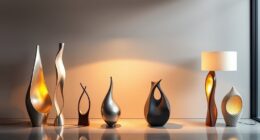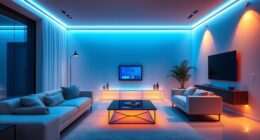To communicate your vision effectively, be clear and specific about your goals and expectations from the start. Share your brand values and desired outcomes, and encourage open dialogue with your designer. Provide actionable feedback, focusing on suggestions rather than criticisms, and listen actively to their insights. Maintain a collaborative, flexible approach, trusting their creative process while guiding it with thoughtful input. For more tips on fostering successful partnerships, keep exploring this topic.
Key Takeaways
- Clearly articulate your project goals, brand values, and desired outcomes early to align expectations.
- Provide specific, actionable feedback instead of vague criticisms to guide design improvements effectively.
- Maintain open communication by asking questions and actively listening to the designer’s insights.
- Share regular updates and hold feedback sessions to keep the project on track and minimize misunderstandings.
- Trust the designer’s creative process and balance guidance with allowing space for experimentation and innovation.

Have you ever wondered how to work effectively with designers to bring your vision to life? Building a successful collaboration hinges on clear communication and mutual understanding. When you engage with designers, providing thoughtful design feedback becomes essential. Instead of just pointing out what you don’t like, focus on specific, actionable suggestions. For example, instead of saying, “I don’t like the color,” try, “Can we explore warmer tones to better match the brand’s energy?” This approach fosters a more productive dialogue and helps designers understand your preferences without feeling criticized. Remember, your goal is to refine the creative process, not to critique the designer’s talent. Offering constructive feedback encourages a positive environment where ideas can evolve naturally.
Achieving a strong creative synergy is the key to transforming your vision into a compelling design. This means maintaining open lines of communication and actively listening to your designer’s insights. When you show genuine interest in their expertise, you create a partnership rooted in respect and shared purpose. Don’t hesitate to ask questions or request explanations about design choices you don’t fully understand. Doing so not only clarifies your expectations but also demonstrates your commitment to the project. As the collaboration progresses, be flexible and willing to adapt your initial ideas based on the designer’s input. This flexibility fuels the creative synergy that leads to innovative solutions you might not have envisioned alone.
To maximize your working relationship, set clear goals from the outset. Share your vision, brand values, and desired outcomes early in the process. This clarity helps designers align their work with your expectations and minimizes misunderstandings. Regular check-ins or feedback sessions are essential; they keep everyone on the same page and allow for ongoing adjustments. Remember, effective communication isn’t just about speaking but also about listening. When you genuinely consider your designer’s perspective and expertise, you foster an environment where ideas flourish. Incorporating professional expertise, such as fuel injection cleaning or grout maintenance, can also serve as an analogy for the importance of specialized knowledge in achieving quality results.
Finally, trust the process and respect the designer’s creative process. While your input is fundamental, giving designers space to experiment and explore can lead to unexpected and exciting results. By balancing your vision with their creative expertise, you develop a partnership that’s both productive and inspiring. When you prioritize thoughtful design feedback and nurture a collaborative spirit, you set the stage for a project that truly captures your vision while elevating the designer’s craft. Through this approach, your collaboration becomes a dynamic exchange that brings out the best in both of you.
Frequently Asked Questions
How Do I Choose the Right Designer for My Project?
To choose the right designer, start by reviewing their portfolios to see if their style aligns with your project goals. Look for branding consistency across their work, ensuring they can maintain a cohesive visual identity. Consider their experience with similar projects and how well they understand your vision. Trust your instincts, ask about their process, and choose someone who communicates clearly and shows enthusiasm for bringing your ideas to life.
What Should I Include in a Creative Brief?
Oh, because a vague idea magically turns into stunning visuals, right? Include your branding strategy so the designer knows your core message. Clearly outline your target audience, project goals, and deadlines to keep everyone on track. Don’t forget visual storytelling—share mood boards, color schemes, and style preferences. The more specific you are, the better your designer can craft a compelling visual narrative that truly resonates.
How Can I Handle Disagreements During the Design Process?
When disagreements arise during the design process, you should address them openly and respectfully. Focus on understanding the other person’s perspective, especially regarding ethical considerations and cultural sensitivities. Keep communication clear and collaborative, seeking common ground. If needed, involve a neutral third party or refer back to your initial creative brief to guarantee your vision aligns with ethical standards and cultural awareness, fostering a positive and inclusive working environment.
What Are Effective Ways to Give Constructive Feedback?
Start with a sincere, specific compliment to set a positive tone. Then, use visual language to clearly explain what works and what doesn’t, focusing on facts over feelings. Employ feedback techniques like the “sandwich method”—highlighting strengths, suggesting improvements, and reaffirming positives. Keep your comments clear, concise, and constructive, encouraging dialogue and development. Remember, effective feedback fosters growth, so stay respectful, relevant, and responsive throughout the process.
How Do I Set Realistic Timelines for Design Collaboration?
To set realistic timelines, start by defining clear project milestones and understanding the scope of the design work. Communicate openly with your team about deadlines and potential challenges, allowing for buffer time to accommodate revisions. Use deadline management tools to track progress and adjust schedules if needed. Breaking down tasks into smaller steps helps guarantee each part stays on track, making the overall timeline attainable and keeping everyone aligned.
Conclusion
Now that you know how to communicate your vision clearly, imagine the moment your ideas come to life—colors blending perfectly, details aligning seamlessly. But the real magic begins when your collaboration pushes boundaries you hadn’t considered. Are you ready to see your concept transform into something extraordinary? Keep honing your skills and stay open to surprises. Because in the end, it’s those unexpected sparks that turn a good project into a masterpiece.









